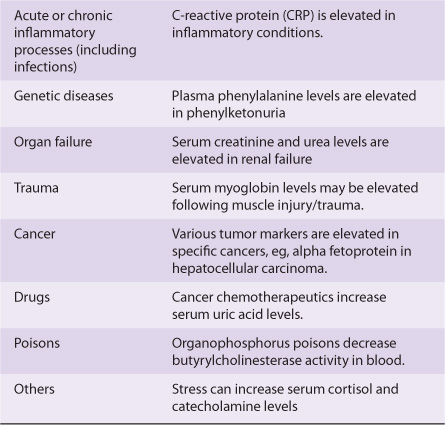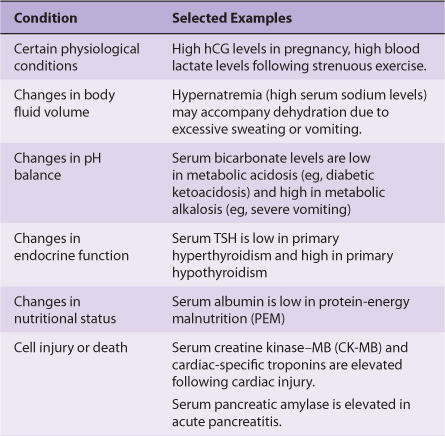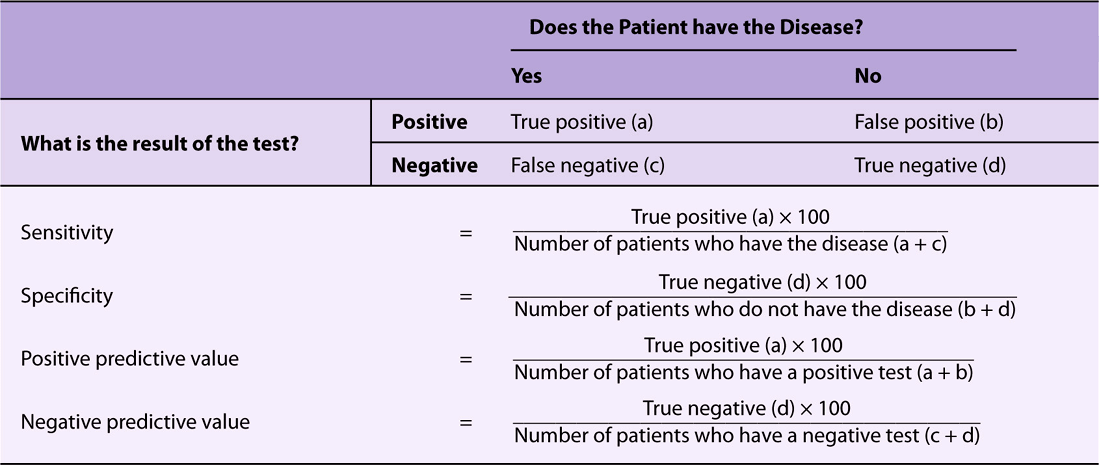56
Clinical Biochemistry
Joe Varghese, MB BS, MD, Molly Jacob, MB BS, MD, PhD, & Robert K. Murray, MD, PhD
OBJECTIVES
After studying this chapter, you should be able to:
![]() Briefly describe the importance of biochemical tests in clinical medicine.
Briefly describe the importance of biochemical tests in clinical medicine.
![]() Discuss major considerations to be kept in mind when ordering and interpreting results of laboratory tests.
Discuss major considerations to be kept in mind when ordering and interpreting results of laboratory tests.
![]() Name and have a general understanding of the principal tests used to assess liver, kidney, thyroid, and adrenal function.
Name and have a general understanding of the principal tests used to assess liver, kidney, thyroid, and adrenal function.
IMPORTANCE OF LABORATORY TESTS IN CLINICAL MEDICINE
Laboratory (lab) tests play an important role in helping physicians and other healthcare workers make diagnoses and other clinical judgments. In this chapter, only biochemical tests (and not hematological, microbiological, immunological, or other types of tests) are discussed, with a few exceptions. In addition, only a brief overview of this subject is presented; medical students will receive much further coverage as they progress through the years of their medical education.
Lab tests constitute only one part of the diagnostic process in clinical medicine. In fact, it has been stated that an experienced physician may arrive at a relatively accurate diagnosis in ~80% of cases, based solely on a thorough history and physical examination; some may, however, doubt the validity of this statement. However, there is no doubt that, nowadays, biochemical and other lab tests are almost always an important part of the overall diagnostic process. The use of biochemical investigations and lab tests is, however, not confined to diagnoses of diseases. Table 56-1 summarizes some of the different uses of biochemical tests, with examples for each.
TABLE 56–1 Major Uses of Biochemical Tests with Selected Examples for Each
Two important questions that one should answer prior to ordering any lab investigation are: “What useful information will I get by ordering this test?” and “Will it help the patient?” The concepts discussed in this chapter will contribute to answering these questions and help one make wise use of lab tests in the management of patients.
CAUSES OF ABNORMALITIES IN LEVELS OF ANALYTES MEASURED IN THE LABORATORY
A myriad of conditions and disorders can lead to abnormalities of levels of various molecules (analytes) measured in clinical labs. Some of these are listed in Table 56-2.
TABLE 56–2 Common Causes for Abnormalities in Analytes Measured in Clinical Labs

It is clear from this Table that conditions that cause abnormal levels of analytes are diverse. For instance, when tissue injury occurs, it results in damage to cell membranes and an increase in the permeability of the plasma membrane of affected cells. This leads to leakage of intracellular molecules into the blood (eg, leakage of troponins into blood following a myocardial infarction), causing their blood levels to increase. In other cases, the synthesis of certain molecules is increased or decreased (eg, C-reactive protein [CRP] in inflammatory states or specific hormones in certain endocrine disorders). Kidney and liver failure lead to the accumulation of a number of molecules (eg, creatinine and ammonia respectively) in the blood, due to an inability of the organ concerned to excrete or metabolize the analyte concerned.
VALIDITY OF LABORATORY RESULTS
Good diagnostic labs are subject to inspection and regulatory procedures on a regular basis. These assess the validity of their results and ensure quality control of their reports. Such measures will ensure that the value of the concentration, activity, or amount of a substance in a specimen reported from a clinical lab represents the best value obtainable with the method, reagents and instruments used and technical personnel involved in obtaining and processing the specimen. In addition, it is important for medical personnel to possess basic knowledge about the validity of lab results and their interpretation. It is also good practice to visit labs and to discuss, with appropriate lab personnel, questions, and problems that may arise with regard to values of lab results.
Accuracy is the degree of agreement of an estimated value of an analyte with the “true” value of the analyte in the sample. Precision denotes the reproducibility of an analysis and is the ability of the method used to consistently produce the same value when an analyte in a sample is repeatedly measured. It is expressed as the variation seen when these repeated measurements of the analyte are done. Precision is not absolute, but is subject to variation inherent in the complexity of the method used, the stability of reagents, the accuracy of the primary standard used, the sophistication of the equipment used for the assay and the skill of the technical personnel involved. Each lab should maintain data on precision (reproducibility) that can be expressed statistically in terms of the standard deviation (SD) from the mean value obtained by repeated analyses of the same sample.
For example, the precision in determination of cholesterol in serum in a good lab may be the mean value of repeated estimations with a SD of 5 mg/dL. The 95% confidence limits for this assay are ± 2 SD or ±10 mg/dL. This means that any value reported is “accurate” within a range of 20 mg/dL. Therefore, a reported value of 200 mg/dL signifies that, in 95% of cases, the true value lies between 190 and 210 mg/dL. Similarly, for the determination of serum potassium levels in a specimen, a SD of ± 0.1 mmol/L indicates that the 95% confidence limit of ± 2SD for this assay is ± 0.2 mmol/L. Thus, a potassium value of 5.5 mmol/L indicates that, in 95% of cases, the true value lies in the range 5.3-5.7 mmol/L. Values of 5.3 and 5.7 mmol/L may be obtained on repeated analysis of the sample and will still be within the limits of precision of the test.
ASSESSMENT OF VALIDITY OF A LAB TEST
The clinical value of a lab test depends on its specificity, sensitivity, and the prevalence of the disease in the population tested.
Sensitivity is the percentage of positive results in patients with the disease. Ideally, a test should have 100% sensitivity. However, this is seldom attained. For example, the carcinoembryonic antigen (CEA) test has a lower than ideal sensitivity; only 72% of those with carcinoma of the colon test positive when the disease is extensive, and only 20% test positive when they have early disease. Lab tests often have lower sensitivity in the early stages of many diseases, in contrast to their higher sensitivity in well-established disease. In biochemical analysis, sensitivity refers to the ability of the method to detect small changes in the levels of the analyte. The lowest concentration of the analyte that can reliably be detected is called the limit of detection. Usually, a highly sensitive test will have a very low limit of detection.
Specificity refers to the percentage of negative results among people who do not have the disease. Ideally, tests should be 100% specific. The CEA test for carcinoma of the colon has a variable specificity; about 3% of non-smoking individuals give a false-positive result (97% specificity), whereas 20% of smokers give a false-positive result (80% specificity). In biochemical analysis, specificity may also indicate if substances or factors other than the one being measured influence the assay in any way (positive or negative interference).
The predictive value of a positive test (positive predictive value) defines the percentage of positive results that are true positives. Similarly, the predictive value of a negative test (negative predictive value) defines the percentage of negative results that are true negatives. This is related to the prevalence of the disease. For example, in a group of patients in a urology ward, the prevalence of renal disease is higher than in the general population. In this group, the level of serum creatinine will have a higher predictive value than in the general population. Formulae for calculating sensitivity, specificity, and predictive values of a diagnostic test are shown in Table 56-3.
TABLE 56–3 Two-By-Two Table Illustrating Concepts of Sensitivity, Specificity and Predictive Values
An ideal diagnostic test is one that has 100% sensitivity and 100% specificity. However, this is not true for most, if not all, tests available nowadays. Before ordering a test, it is important to attempt to determine whether the sensitivity, specificity, and predictive value of the test are adequate to provide useful information. The result obtained should influence diagnosis, prognosis, or therapy or lead to a better understanding of the disease process and benefit the patient.
VARIABLES THAT AFFECT VALUES OF ANALYSIS
Apart from age and sex, many other factors (called preanalytical variables) may affect values of analytes and influence their normal ranges. These include race, environment, posture (supine vs. sitting), diurnal and other cyclic variations, pregnancy, fasting or postprandial state, foods eaten, drugs, and level of exercise.
Stay updated, free articles. Join our Telegram channel

Full access? Get Clinical Tree





